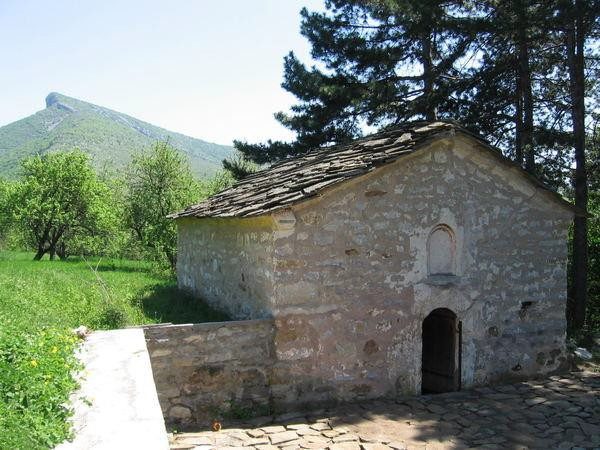

“St. John the Baptizer” Church is not far from the center of Varbovo. According to the data from the archives of Vidin, the diocese is aware that Varbovo church already existed since 1600, according to a commemorative inscription inside the nave which is known to be written in 1652. In 1898, the narthex it was restored, the commemorative inscription was copied again. The church is ruined and plundered in the 60s of last century by masters students from the Academy of Arts, and was restored in the 90s of XXth century. It was declared a national historic monument in 1927 and art architectural monument in 1973.
The temple is a typical representative of the church building from Bulgarian provinces of the XV-XVII century. Its appearance is quite impersonal. It is constructed so as to be hardly noticed by the eyes of the Turks, but instead the inside space has a strong spiritual impact, much better than external space. Inside the church we have a vessel, stone building with a large semicircular apse, with two windows on the south wall and from the western entry. The building dimensions are: length – 7.50 m; width – 5.90 m; wall thickness. – 0.90 m and the cylindrical vault is covered on the outside with stone slabs. The interior space is crossed by thick wooden beams placed quite rare. In the space of the altar on the east side are traditional niches and on the north wall – is the laundery room. To the medieval church was added much later the western ramshackle narthex, which today does not exists anymore.
The entire interior of the church was decorated with frescoes. Today, most of these are well preserved, except for those of the arch, which have small lesions that have appeared on the ceiling because water leakage. The picturesque decoration of the temple is one of the rare works from the middle of the eighteenth century, especially valuable as technical and artistic performance.
The distribution of mural painting is as follows: in the middle of the arch inside a large circle is represented Christ Pantocrator surrounded by 12 medallions with images of the apostles. To the east of this composition is represented Christ and to the west is represented Christ Emanuel. On either side of the latter compositions are two rows of six medallions with images of prophets. Onto the arch curve down into rectangular fields on the two lanes were painted scenes from the life of Christ, and in the following lines are shown scenes from the life of St. Demetrius, St. George, St. Mary and others. Inside the apse is represented Mary, and under it, in a number of 6 are placed the pictures of the the Church Fathers. On the western wall above the door were painted four scenes: at the top is “Ascension of the Lord” and underneath in a row – “The burial”, “Assumption of the Virgin” and “Resurrection”. In the first belt over the holder on the wall from the north and south, there were images of saints in full length, but very few have lasted until today. On the southern wall between two windows, is being depicted the church patron St. John the Baptizer, with an unusual posture. This image is an rare representation, and perhaps there is only one scene in Bulgarian iconography of the life of St. John the Baptizer. In the composition are combined two moments: the first saint is described as a small boy with a halo on his head, which wanders the desert, led by an angel, and next to him is another angel which is together with John the Baptizer. An impressive scene from the life of John the Baptizer is particularly the scene “Herod’s banquet. ” Again, the first part of the western wall towards the left of the door, over the entire length is St. Michael, and the images coming from the right side of the entrance present St. Constantine and Elena. The iconographic style of Varbovo church is represented in the ruined church of “St. Nicholas” Zhelezna (frescoes are preserved in the National Archaeological Museum) and in the church “Virgin Mary” in Sichevachkiyat monastery (near Nis, Serbia today). The painters who worked in Sicevo are not known by their name. M. Rakozi, revealed frescoes from Sicevo and offers some general parallels, but does not mention other works of the studio. These artists have probably painted the narthex of the Temska monastery (1654) and the narthex of the church of “St. John the Baptist” from Jašunja which D. Subotic dates it from about the middle of the eighteenth century. The artists of the studio worked in a relatively large area around Suva and Chiprovtzi, a part of Stara Planina.
Veil of the temple is carved much later, and was made in the nineteenth century. Today, the icons of the iconostasis are not preserved, all were stolen during communism regime. Has survive only an icon of St. Mary, which stood in the beginnings inside the narthex, which is now disbanded. The painting is of the representative of Tryavna art school – Vitan Nikolov in 1889. In the cemetery is preserved the gravestone plate with the inscription “the priest of the Age Stoyu in year 1797”.
